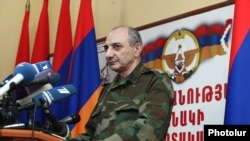U.S., Russian and French mediators visited Nagorno-Karabakh and met with its leadership on Thursday as part of international efforts to prevent the Armenian-Azerbaijani conflict from escalating into a full-scale war.
The three co-chairs of the OSCE Minsk Group -- James Warlick, Igor Popov and Pierre Andrieu -- arrived in Stepanakert from Baku two days after a Russian-brokered agreement largely stopped the heaviest fighting around Karabakh since 1994, which broke out on Saturday. Warlick said ahead of the talks with Karabakh leaders that they expect to “hear first-hand about the violence.”
General Levon Mnatsakanian, the commander of the Karabakh Armenian army, was the first to meet with the mediators accompanied by Andrzej Kasprzyk, the top OSCE official monitoring the ceasefire regime in the conflict zone.
A statement by the army said Mnatsakanian presented them with “irrefutable evidence of the Azerbaijani military aggression” against the Armenian-populated territory. It said the mediators stressed the need for urgent steps aimed at a peaceful resolution of the Karabakh dispute.
The mediators were due to meet with Bako Sahakian, the Karabakh president, later in the evening. “We have a number of views and demands relating to the current situation and will naturally present them to the Minsk Group co-chairs,” Sahakian told reporters ahead of the meeting.
Warlick, Popov and Andrieu met with Azerbaijani President Ilham Aliyev in Baku on Wednesday. The U.S. envoy reportedly reaffirmed their view that the conflict cannot be resolved militarily.
Russian Foreign Minister Sergey Lavrov also met with Aliyev when he arrived in the Azerbaijani capital later on Wednesday for a trilateral meeting with his Azerbaijani and Iranian counterparts. Lavrov said after those talks on Thursday that progress in Armenian-Azerbaijani peace talks is needed to prevent a repeat of the unprecedented escalation of the conflict.
“As a country with close and good neighborly relations with both countries (Armenia and Azerbaijan), Russia will do everything to find a political solution to the conflict,” Russian media quoted Lavrov as saying. He said that the three mediating powers are “very close” to making their peace proposals acceptable to the conflicting parties. He did not go into details.
Sahakian said, meanwhile, that the ceasefire, which took effect on Tuesday, is “largely holding” despite what he called sporadic gunfire from Azerbaijani forces deployed along “the line of contact” around Karabakh. “If Azerbaijan again breaches the ceasefire, then the armed forces of the Nagorno-Karabakh Republic … will deal the next necessary blow to the enemy,” the Karabakh leader warned at a news conference in Stepanakert.
Colonel Viktor Arustamian, the Karabakh army spokesman, confirmed that tensions on the frontline have decreased “considerably.” Still, Arustamian said one Armenian soldier was wounded by enemy fire and the Armenian side shot down yet another Azerbaijani unmanned aerial vehicle (UAV) on Thursday.
The Azerbaijani military also claimed to have brought down an Armenian UAV.






